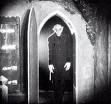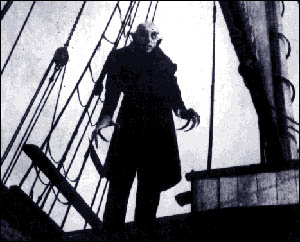
by Kally Mavromatis
A million fancies strike you when you hear the name: Nosferatu!
N O S F E R A T U
does not die!
What do you expect of the first showing of this great work?
Aren't you afraid? - Men must die. But legend has it that a vampire, Nosferatu, Ôder Untote (the Undead), lives on men's blood! You want to see a symphony of horror? You may expect more. Be careful. Nosferatu is not just fun, not something to be taken lightly. Once more: beware.
- Publicity for Nosferatu in the German magazine Buhne und Film, 1922
The myth of the vampire is a powerful one, rooted in ancient traditions and beliefs. The themes of blood, sex, and death are intertwined throughout recorded history, prominent even in modern-day religions.
Vampire legends have persisted through generations of oral tradition. The name, Nosferatu, taken from the old Slavonic for "plague-carrier," was widely understood to describe a reanimated corpse which returns at night to prey on the living. In an age of inexplicable, widespread disease and epidemic, the Vampire became the scapegoat, literally accused of sucking [one's] life out.
Vampire lore also draws upon such historical figures as Baron Gilles de Rais and Countess Elizabeth Bathory. de Rais, at one time a personal bodyguard to Joan of Arc, harbored a bloodlust that he satisfied with the molestation and torture of over 150 young boys. Bathory comes closer to fulfilling the Dracula stereotype: Born in the horseshoe of the Carpathians, it is believed that she alone was responsible for torturing and killing as many as 600 young girls, then bathing in their blood. Blood, she believed, would keep her skin young and fresh.
 The vampire made its first literary appearance in The Vampyre, published in 1819. Although frequently and mistakenly credited to Lord Byron, Dr. John Polidoro's story of a decadent young aristocrat who preys upon the blood of young girls is all the more notable for its portrayal of the vampire as seducer, and not the predatory, beast-like creature of legend.
The vampire made its first literary appearance in The Vampyre, published in 1819. Although frequently and mistakenly credited to Lord Byron, Dr. John Polidoro's story of a decadent young aristocrat who preys upon the blood of young girls is all the more notable for its portrayal of the vampire as seducer, and not the predatory, beast-like creature of legend.
In Stoker's story, however, the vampire matures. The image is polished and refined, the vampire now a sophisticated, elegant, intelligent creature. The combination of raw sensuality and civilized manners was a potent one for Victorian-era readers, a mirror of the duality of the era itself. Interpretations on the popularity of the novel vary, but all center on one basic thesis: that of the tale as allegory for psycho-sexual dynamics in the Victorian age.
With its motifs of love and death, sex and blood, the dramatic possibilities of Dracula made it a natural fit for the theatre, then later the budding film industry. But while Nosferatu was not the first vampire film, like any decent vampire it refused to die.
Prana-Film, so named for the Buddhist concept of prana, or breath-as-life, was formed in January 1921. While planning to release an ambitious roster of occult oriented films, Nosferatu was to be its first and only release.
Originally titled Nosferatu, Eine Symphonie des Grauens (Nosferatu, a Symphony of Horror), the film was shot on location (a rarity at that time) in the summer of 1921.
Director F.W. Murnau makes elegant use of the highly stylized, post-war Expressionist movement in his sets, lighting, and mood. Following in the tradition of such films as The Golem (the first version was co-written by Galeen, scriptwriter for Nosferatu) and The Cabinet of Dr. Caligari, the distortion, exaggeration, extreme metaphor, and overriding emphasis on composition and shadow play make for a lyrical film, full of dramatic pictorial compositions. Interestingly, much of the film deviates from Murnau's carefully annotated script, implying that a great deal of what was shot was improvised.
 Because the use of Expressionism tended toward the contrived, it is Murnau's use of naturalism and Expressionism side-by-side that jars the viewer, achieving a heightened sense of horror and suspense. Pure Expressionist films such as Caligari were filmed entirely indoors, making full dramatic use of the distorted and exaggerated scenery and lighting. But because much of Nosferatu was shot outdoors in daylight, the indoor and/or night scenes with Count Orlock, with their overarching use of Expressionism, carry that much more impact.
Because the use of Expressionism tended toward the contrived, it is Murnau's use of naturalism and Expressionism side-by-side that jars the viewer, achieving a heightened sense of horror and suspense. Pure Expressionist films such as Caligari were filmed entirely indoors, making full dramatic use of the distorted and exaggerated scenery and lighting. But because much of Nosferatu was shot outdoors in daylight, the indoor and/or night scenes with Count Orlock, with their overarching use of Expressionism, carry that much more impact.
One particularly memorable scene in the film is of Hutter being taken to Orlock's castle. By now, dusk has fallen, and the villagers refuse to take Hutter to the castle. Out of the forest surrounding Orlock's castle appears a carriage, seemingly with no driver. While the carriage carries Hutter up the mountain, the entire journey is bathed in an eerie white glow. According to Murnau's close friend and assistant Edgar Ulmer, in an interview in the French cinema publication Midi-Minuit Fantastique, Murnau was heavily influenced by Swedish director Mauritz Stiller, whose work gave Murnau the idea for using negative film for the ride to the Orlock's castle to achieve its otherworldly effect.
But without a doubt the film's most visceral image is Max Schreck as Count Orlock. Defying all interpretations of the Vampire before or since, Schreck's Orlock is the embodiment of evil: the long, talon-like fingers, the ghostly pallor, the sunken eyes. Indeed, Schreck more accurately reflects the corpse of the un-dead that he is, after all, purported to be, differing greatly from the modern interpretations of Dracula the vampire.
Reaction to the film was favorable, but while it was generally well-received by audiences and critics it was not well-received by the author's widow. Despite the fact that Nosferatu bears little resemblance to Stoker's story, there were enough similarities to justify a claim of infringement.
Left virtually penniless by her husband, Florence Stoker had come to rely on the steady if paltry income provided by sales of "Dracula." Alerted to the film's Saturday, March 4, 1922 premiere at the Marble Hall of the Berlin Zoological Gardens, Florence engaged the services of G. Herbert Thring of the British Incorporated Society of Authors to file suit. Unfortunately for Stoker, however, publicity spending for Nosferatu had far outstripped the nascent studio's resources, sending Prana-Film into receivership by the summer of 1922. Although in July of 1925 the German courts ordered all prints of the film destroyed, Stoker had yet to be compensated for infringement.
Negatives of the film, however, continued to migrate throughout the continent, and alerted to showings in other countries, Florence Stoker continued to pressure the Society of Authors to continue the legal battle. Despite the increasingly convoluted nature the suit was taking, the Society continued to fight on her behalf. Florence was able to prevent the film's London premiere in 1925, but four years later the film reached American screens.
The film was not an immediate critical or commercial success. Not until after World War II would Nosferatu gain classic status. In 1957, Murnau's 1926 film The Last Laugh was voted among the ten best by an international jury at the Brussels International Exposition. While Murnau's films had continued to be well-regarded in French film journals, not until the Exposition was the director and his body of work reevaluated.
Despite seeming relatively tame by today's blood-drenched standards, Nosferatu still stands as one of the greatest horror films ever made. The film is an enduring testament to the art of silent film making, skillfully conveying the storyıs horror and tragedy without having to say one word.
To buy:
[Home] [News & Notes] [The Features Page] [The Store] [At the Movies]
[The Calendar] [Silent Era Facts] [Silent Star of the Month]
only1kcm@yahoo.com
 The vampire made its first literary appearance in The Vampyre, published in 1819. Although frequently and mistakenly credited to Lord Byron, Dr. John Polidoro's story of a decadent young aristocrat who preys upon the blood of young girls is all the more notable for its portrayal of the vampire as seducer, and not the predatory, beast-like creature of legend.
The vampire made its first literary appearance in The Vampyre, published in 1819. Although frequently and mistakenly credited to Lord Byron, Dr. John Polidoro's story of a decadent young aristocrat who preys upon the blood of young girls is all the more notable for its portrayal of the vampire as seducer, and not the predatory, beast-like creature of legend.
 Because the use of Expressionism tended toward the contrived, it is Murnau's use of naturalism and Expressionism side-by-side that jars the viewer, achieving a heightened sense of horror and suspense. Pure Expressionist films such as Caligari were filmed entirely indoors, making full dramatic use of the distorted and exaggerated scenery and lighting. But because much of Nosferatu was shot outdoors in daylight, the indoor and/or night scenes with Count Orlock, with their overarching use of Expressionism, carry that much more impact.
Because the use of Expressionism tended toward the contrived, it is Murnau's use of naturalism and Expressionism side-by-side that jars the viewer, achieving a heightened sense of horror and suspense. Pure Expressionist films such as Caligari were filmed entirely indoors, making full dramatic use of the distorted and exaggerated scenery and lighting. But because much of Nosferatu was shot outdoors in daylight, the indoor and/or night scenes with Count Orlock, with their overarching use of Expressionism, carry that much more impact.